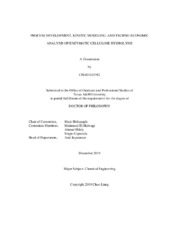| dc.description.abstract | Countercurrent saccharification is a promising way to minimize enzyme loading while obtaining high conversions and product concentrations. However, in countercurrent saccharification experiments, 3–4 months are usually required to acquire a single steady-state data point. To save labor and time, simulation of this process is necessary to test various reaction conditions and determine the optimal operating point. Previously, a suitable kinetic model for countercurrent saccharification has never been reported. To simulate countercurrent saccharification, a kinetic model that could satisfactorily predict batch saccharification under various reaction conditions is necessary. In this study, the HCH-1 model was modified to extend its application to integrated enzymatic hydrolysis; it performed well when predicting 10-day cellulose hydrolysis at various experimental conditions. Comparison with the literature models showed that the modified HCH-1 model provided the best fit for batch enzymatic cellulose hydrolysis. The Continuum Particle Distribution Modeling (CPDM) was applied to simulate countercurrent saccharification of α-cellulose. The modified HCH-1 model was used as the governing equation in the CPDM model. When validated against experimental countercurrent saccharification data, it predicts experimental glucose concentrations and conversions with the average errors of 3.5% and 4.7%, respectively.
CPDM predicts conversion and product concentration with varying enzyme-addition location, total stage number, enzyme loading, liquid residence time, and solids loading rate. In addition, countercurrent saccharification was compared to batch saccharification at the same conversion, product concentration, and reactor volume. Results show that countercurrent saccharification is particularly beneficial when the product concentration is low. Techno-economic analysis was performed for cellulosic sugar production. Various reaction conditions, equipment materials, enzyme unit prices, and return on investments (ROIs) were considered. Excluding feedstock cost but including utility cost (dewatering), enzyme cost, depreciation, and fixed operating costs, using geomembrane reactor and carbon steel mechanical vapor recompression (MVR) evaporators, the estimated minimum selling prices are $0.079/kg glucose with commercial CTec2 cellulase ($6.27/kg protein) and $0.064/kg glucose with on-site cellulase production ($4.24/kg protein). Compared to batch saccharification at the same reaction conditions, equipment materials, and enzyme unit prices, countercurrent saccharification significantly reduces the cost of cellulosic sugar production. | en |


